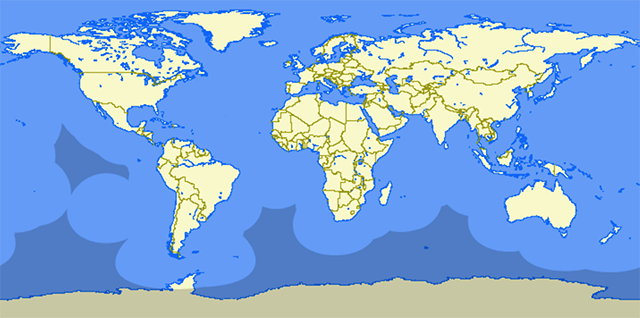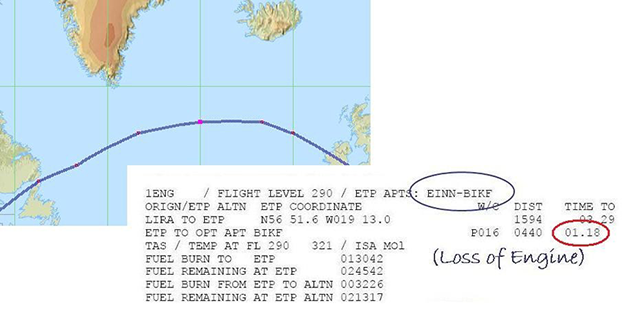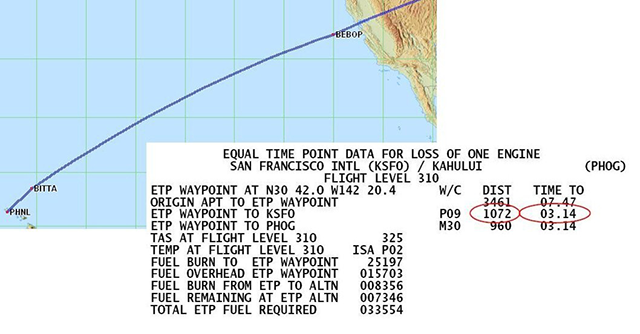As turbine engines have become more and more reliable the definition of what constitutes extended operations has changed. Even the name has changed: ETOPS started out at "Extended Twin Operations" and than became "Extended Operations. ETOPS is now EDTO, "Extended Diversion Time Operations." What remains constant is confusion among many pilots as to what it means, who it impacts, and how to "comply."
— James Albright

Updated:
2020-12-30
- What it means, for most aircraft, is any operation that is beyond 180 minutes with one engine inoperative from a suitable airport.
- Who it impacts are commercial operators, 14 CFR 121 and 135.
- How to comply is quite complicated, involves many steps for pilots, mechanics, the airplane and the operator.
This isn't an article about becoming ETOPS eligible, it is an article on how to fly just about everywhere in the world without having to become ETOPS certified.
Under 14 CFR 135, to fly without ETOPS certification, you need to demonstrate that the aircraft can make it to a suitable airport in under 180 minutes, using engine-out altitudes and airspeeds of your choosing. You do not need to use Equal Time Point (ETP) altitudes and speeds. If you have the fuel and performance to do this, the rule book is satisfied. Under real engine-out situations, the actual altitudes and airspeeds are up to you and you need not do this in under 180 minutes.
None of this make sense to you? If you fly more than 3 hours from the nearest airport under 14 CFR 135, you need to understand ETOPS. If you fly a Challenger or Boeing it may not impact how you fly over water at all, but you need to know why. If you fly a Gulfstream, however, ETOPS may impact your fuel loading.

1
Location
To find your aircraft's 180-minute range you can use the excellent website, Great Circle Mapper and input a true airspeed to produce a chart like the one shown here. A GV's Engine-Out 180-minute foot print can be figured at 358 KTAS but the selected speed is up to the pilot. Losing an engine in the dark shaded areas means you cannot get to a suitable alternate in less than 180 minutes. To fly this under 14 CFR 135, you would need to be certified for ETOPS.
Maximum flying time outside the United States. After August 13, 2008, no certificate holder may operate an airplane, other than an all-cargo airplane with more than two engines, on a planned route that exceeds 180 minutes flying time (at the one-engine-inoperative cruise speed under standard conditions in still air) from an Adequate Airport outside the continental United States unless the operation is approved by the FAA in accordance with Appendix G of this part, Extended Operations (ETOPS).
Source: 14 CFR 135, §135.364
If you are flying under 14 CFR 135 and your planned range exceeds 14 CFR § 135.364 criteria, you and your airplane have to meet 14 CFR 135 Appendix G requirements. This is an expensive and time consuming process.
Aircraft not under an ETOPS program must be able to return to an acceptable airport within 180 minutes (in still air) in the event of an engine failure.

GV 180-minute, 358 KTAS ETOPS Map, from Great Circle Mapper
2
Obtaining ETOPS certification
If you want to get ETOPS certified I recommend you contact your aircraft manufacturer and start from there. If you spend considerable time flying routes where your aircraft is impacted, it might be worth your while.
Most aircraft are grand fathered into a 180-minute engine-out capability, which means they may fly as far as 180 minutes from the nearest suitable airport engine-out, no wind, but no further.
Refer to 14 CFR 135 Appendix G to determine your 180-minute engine out qualification:
- 14 CFR 135.98, Operations in the North Polar Area
- 14 CFR 135.364, Maximum Flying Time Outside the United States
- 135.411, Maintenance Requirement Applicability
- 135 Appendix G, ETOPS
A GIV, GV, G450, and G550 are all 180-minute engine-out qualified. They can qualify for ETOPS, which extends that range to either 207 or 240 minutes, but the process is so time consuming and expensive, I've not heard of a single operator who has bothered.
To be ETOPS qualified, 14 CFR 135 operators must have Operations Specification B342 and B344, as detailed under FAA 8900.1, Volume 4, Chapter 6.
If you plan all of your 14 CFR 135 operations to be within 180 minutes, engine-out of a suitable airport, you do not need ETOPS certification.
3
Example case study: A Gulfstream GV

G450 180-minute Map, from Gulfstream All Aircraft Presentation.
The Gulfstream V, for example, is almost never constrained in the Atlantic but cannot make many locations in the South Pacific from South America westward and remain ETOPS compliant. Between the continental United States and Hawaii, however, the GV is capable provided crews plan fuel to allow altitudes lower than optimal and airspeeds higher than optimal in the event of an engine failure. Technique:
- Flight plan with normal Equal Time Points (ETPs).
- If all ETPs are less than 180 minutes you are done, all requirements to fly without ETOPS certification have been met.
- For any ETP greater than 180 minutes, examine the ETP airspeed and altitude and attempt to increase the KTAS to bring the time below 180 minutes. The GV series, for example, will have a drift down altitude and airspeed which produces the best range but a low KTAS. If the aircraft has the fuel to fly at a lower altitude and higher KTAS, you might be able to reduce the time significantly. If the time cannot be reduced below 180 minutes, the aircraft will not be allowed to fly the route under 14 CFR 135.
More about: Equal Time Points.
Note: you need only plan for the ability to fly the route from any point to a divert airport engine-out in under 180 minutes. In an actual engine-out situation, you may fly speeds and altitudes of your choosing and you don't have to do it in under 180 minutes.
Gulfstream has a very nice presentation on this which includes a page that computes the 180-nm rings for your specific Gulfstream: Gulfstream All Aircraft Presentation. It is important to understand, however, that the presentation is designed to ensure "non-ETOPS operations."
The Explanation - A Short Story
Never since the Boeing 747 had I been so impressed with an airplane. The Gulfstream V showed how a company can take a good idea and build on it. The Gulfstream II was a good airplane with a lot of flaws. The Gulfstream III was marginally better. The Gulfstream IV was a Gulfstream III with a lot of the flaws addressed. The Gulfstream V is almost perfect. You cannot beat the wing.
While the airplane is just about eight feet longer than a GIV, its wing has an extra sixteen feet of span. That translates into a higher ceiling, higher cruise speed, higher climb rates, and a greater payload. But what is really impressive are the things you get less of: approach speed and fuel flows. The range is incredible. We flew from Cincinnati, Ohio to Jeddah, Saudi, Arabia on one tank of gas, a trip of nearly 7,000 nautical miles. The trips from the United States to Europe were never a problem:
The aircraft has legs, no doubt about it. That’s why the flights to Hawaii surprised me.
My first hop to Hawaii in the airplane was from Wilmington, Delaware to Kona, Hawaii in 10.0 hours. I was surprised we could do it in 10 hours. We took off with less than a full load of fuel and we returned using reduced thrust. I was surprised we could do that without full power. Then we flew from San Francisco, California to Honolulu, Hawaii and had a problem with range. I was surprised again.
The problem was Extended Operations (ETOPS) specified for commercial aircraft under 14 CFR 135.364: “. . . no certificate holder may operate an airplane, other than an all-cargo airplane with more than two engines, on a planned route that exceeds 180 minutes flying time (at the one engine-inoperative cruise speed under standard conditions in still air) from an Adequate Airport outside the continental United States unless the operation is approved by the FAA in accordance with Appendix G of this part, Extended Operations (ETOPS).”
Translation? If you lose an engine, you have to be within three hours of an airport. That was never a problem in the four engine aircraft I flew. The regulation didn’t exist back then and they didn’t have a problem meeting the criteria. The Challenger 604—that piece of junk—had no problems getting to and from Hawaii, though even with two engines that airplane was almost out of gas after the ocean hop. The Gulfstream V? We could takeoff with less than full tanks from San Francisco, fly to Hawaii, land, skip the fuel truck, and make it back to San Francisco with gas to spare. So why was ETOPS a problem?
Using standard drift down procedures — something unknown to us in the four-engine world — if you lose thrust on an engine you set the operating engine to its maximum continuous setting, allow the airplane to decelerate to an optimum speed, and then you allow the airplane to drift down to an altitude it can sustain on one engine. Most flight plan providers know this and program the equal time point calculations to do just that.
A normal airplane—one with more fuselage than wing—will have to drift down to the middle twenties and fly a speed around 250 or so. The Challenger 604, for example, may end up at 27,000 feet and 240 KIAS, which equates to 370 nautical miles per hour true airspeed. The airplane can make it to its divert airport in 2 hour 53 minutes, though it will be right at its minimum fuel.
The Gulfstream V, with its massive wing, only needs to descend to 31,000 feet but can slow down to 195 KIAS. It doesn’t have to, but the chart says it can. So the flight planners use these numbers; a higher altitude translates to a lower true airspeed as does the lower indicated airspeed. The airplane, if flown at this altitude and speed, makes it to the divert airport in 3 hours and 14 minutes. An FAA examiner who doesn’t understand the topic well will go ballistic and start the violation paperwork. The pilot needs to understand why the flight planning software is wrong.

GV MT0.60 single engine cruise, from GV Aircraft Operating Manual, §11-06, page 50.
In this example, the pilot need only select an altitude 4,000 feet below optimum and a little faster to beat the 3 hour stop watch:
Time = 1072 / 358.2 = 179 minutes.
The lower altitude will cost extra fuel, but the airplane has that to spare. So long as the pilot ensures there is fuel to do this, the aircraft doesn't need ETOPS certification.
Of course this begs the question: can we always adjust our speed enough to keep under 180 minutes? As it turns out: no.
While not a common flight, a trip from New Zealand to Chile is well within the range of a GV but cannot be made under 14 CFR 135 because of ETOPS-180 requirements. The total flight time is under 10 hours and not much over 5,100 nm. There is only one suitable alternate between Christchurch, New Zealand (NZCH) and Santiago, Chile (SCEL): the Isle de Pascua (SCIP).
The engine-out ETP is already calculated at an optimal altitude in terms for producing the highest available TAS, but even if the TAS is increased to the aircraft's maximum capable, the time to the ETP airport cannot be reduced to under 180 minutes. This flight cannot be accomplished in a GV under 14 CFR 135.
References
(Source material)
14 CFR 135, Title 14: Aeronautics and Space, Operating Requirements: Commuter and On Demand Operations and Rules Governing Persons on Board Such Aircraft, Federal Aviation Administration, Department of Transportation
FAA Orders 8400 and 8900
Gulfstream All Aircraft ETOPS Presentation, Nick Rose and Justin Maas, 31 Jan 2017.
Gulfstream GV Aircraft Operating Manual, GAC-AC-GV-OPS-0002, Revision 30, May 13, 2008
Please note: Gulfstream Aerospace Corporation has no affiliation or connection whatsoever with this website, and Gulfstream does not review, endorse, or approve any of the content included on the site. As a result, Gulfstream is not responsible or liable for your use of any materials or information obtained from this site.



